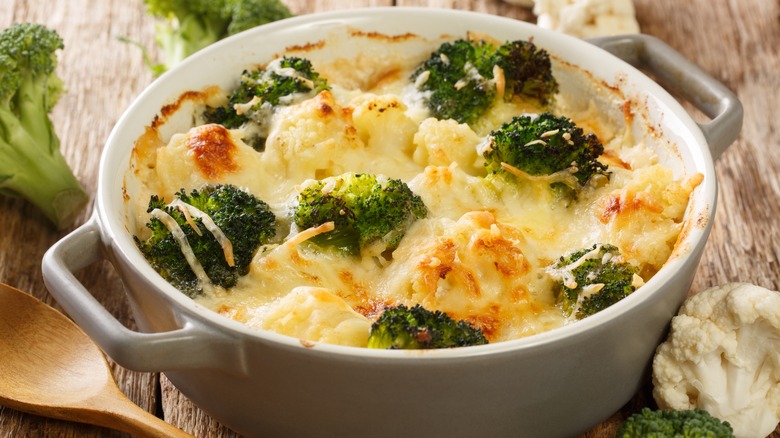The Types Of Casseroles You Probably Shouldn't Freeze
The word "casserole," the Etymology Dictionary tells us, first appeared in 1706, when it meant "stew pan." Its roots are even older, moving back in time to French, Provençal, Medieval Latin, and perhaps even Greek. By 1889 the word referred not only to the cooking vessel, but also to the food prepared in that vessel. So now we can make a casserole in a casserole. Given the ancient roots of the language and the flexibility of the modern term, it's no wonder that casseroles are so versatile. Breakfast, lunch, and dinner — Italian, Mexican, Indian — a casserole can come in any style, and flavor, and be served for any meal.
And one of the best things about casseroles is that some of them can be made ahead and frozen. If you choose your casserole wisely, you can build meals for months to come, and when it's time, you simply thaw and heat. Of course, not all casseroles freeze well. Understanding which casseroles are best for freezing and knowing how to safely freeze, thaw, and heat them is critical for the best results for your homemade dinner-in-a-flash.
There are definitely casseroles that don't freeze well
Allrecipes explains that casseroles that contain dairy, particularly soft cheeses like ricotta, don't freeze very well. Ricotta contains so much moisture that as it reheats, it can steam your casserole and make ingredients mushy. And dairy, in general, can get a bit grainy if it's frozen, then reheated. Likewise, eggs, starchy vegetables, and watery vegetables can make a thawed and reheated casserole a soggy mess. One option for freezing a casserole that calls for a layer of cheese on top is to freeze the casserole sans cheese, thaw the casserole, and then add the cheese right before baking.
In addition, casseroles that contain raw meat should be completely cooked before cooling and freezing, while casseroles that contain cooked meat — like browned ground beef — or meatless casseroles can be frozen uncooked. If you're planning ahead, maximizing freezer space can be a challenge, so we love the tip provided by Taste of Home. They recommend lining your casserole dish with aluminum foil, adding your casserole ingredients, freezing, then removing your meal from the dish.
Wrap your frozen casserole carefully, sealing it completely, and you can store it in a smaller space once you don't have to account for the casserole dish. Once you've reheated your casserole to 165 degrees (via USDA), make sure you let your casserole sit for about 20 minutes to let it firm up so you'll have neater servings with defined layers.

